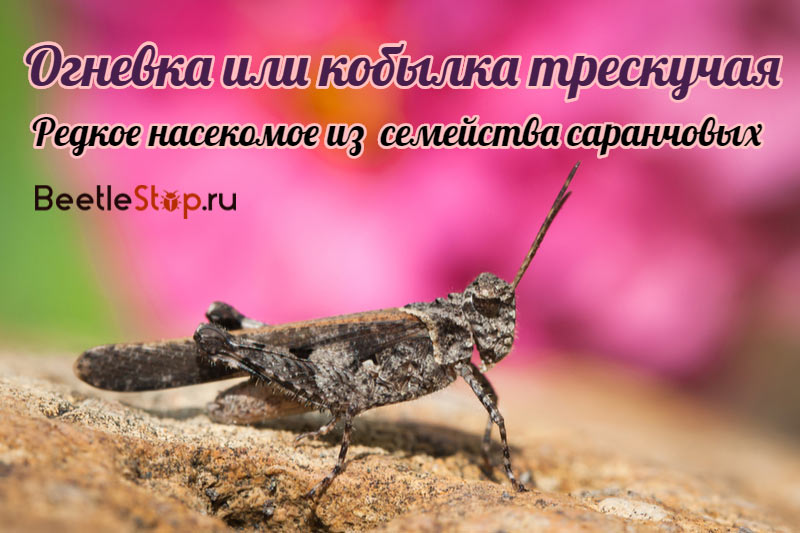Crackling Flame - The Secret of Homely Locusts
At first glance, the crackling moth is no different from other locusts. The body is medium in size, black to brown in color. Only when taking off the insect turns into a bright spark. It turns out that under a plain leathery elytra, a pair of red wings is hidden. Flickering flaming wings easily disorient the enemy, giving the filly the opportunity to stay alive.

View description
Ognevka or Cracking Filly (Psophusstridulus) - an insect from the order Orthoptera, locust family. The adult body is medium in size, males grow up to 22-25 mm, females are larger - 30-40 mm. Sexual dimorphism is manifested not only in size, but also in the color of the filly. Males are dark brown or black, gray spots on extremities. Females are yellowish, gray or brown.
The head of the insect is triangular in shape, when viewed in profile, the crown of the head and forehead converge at right angles. The faceted structure of the eyes allows locusts to determine the shape and color of an object. Short filiform tendrils are the organ of touch. During the flight, they help navigate the air currents. The oral apparatus is equipped with powerful jaws.
Interesting fact. The stridulation organ or sound apparatus that creates the chatter of locusts in the crackling filly is peculiarly arranged. Unlike other representatives of the family, the tubercles are located on the wings, and on the thigh there is a fringing edge.
The chest of insects is protected by durable plates located on the sides and top. This is a pronotum. The middle keel is sharp and long, extending from the toe to the triangular end of the plate. The intersection of the transverse groove is almost imperceptible. Indented depressions are present on the lateral parts. Pronotum painted in tone of the whole body. The chest is usually bare, but some individuals have rare hairs.
The elytra of the moths are dense, leathery, in males go beyond the knees of the hind legs, in females it is shorter. The wings are wide, folding fan-shaped. Painted in bright red, black spots on the tops. The development of wings depends on gender; in males they are full. Insects fly several meters. The wings of the females are weak, not all individuals are able to fly. In air, a species is most easily identified by the color of its wings and characteristic sounds.
Interesting fact. During the flight, males of the species Psophusstridulus emit a loud crack. Its reason is the thorn of the convex veins of the wings on the elytra. Females, when they rise into the air, fly silently.
Locusts have 3 pairs of limbs. Front and middle walking type, they are similar to each other in length and structure. Hind legs hopping. Their hips are muscular and flattened, on the outer surface a pair of keels and light bandages. Shin is black-brown, light in base, covered with spikes. The foot is three-segmented, on it a pair of claws and a suction cup.
Distribution area
Cracking moth species is found in the eastern Palaearctic zone - in the south of Siberia, the Far East, Kazakhstan, Mongolia and Korea. Insects live in the Northern and Central regions of Europe: Austria, Finland, Hungary, Belarus, Germany, the Baltic countries.
Lifestyle
Fillings are found in deciduous forests, forest-steppes, kept on lawns, edges and clearings, well warmed by the sun.The number of insects often fluctuates, the peak falls on dry warm years. Locusts feed on the leaves of plantains, cereals, geranium crops, eat plant litter. Adults are active from July to mid-October. They are difficult to notice among the vegetation due to camouflage coloring.
Insects spend most of the time on soil, climb plants only for nutrition. Activity is shown in the daytime, basking in the sun. Males are shy, often make jumps, so they are easy to find in the grass. Females lead a secretive lifestyle.
Propagation Features
In the mating season, the filly seeks partners with the help of chirping sounds. Fertilized females lay 12-35 eggs in a capsule formed by a foamy secret. Masonry depth up to 10 mm. The eggs are left to hibernate. Larvae appear next summer.
Insect conservation status
In the northwestern part of Europe, codling mares have lost a significant area of habitat. This is due to the development of wasteland for agricultural land. Species Psophusstridulus completely disappeared in Belgium and the Netherlands, is listed in the Red Book of Germany and Sweden. Insects are endangered in Poland, Switzerland. France.
On the territory of Russia, fireplugs fell into the Red Books of several regions: Moscow, Tula, Belgorod. The reduction in the number of insects is caused by the development and plowing of habitats, grass bollards, and grazing. To preserve natural conditions, it is necessary to reduce the recreational load.

